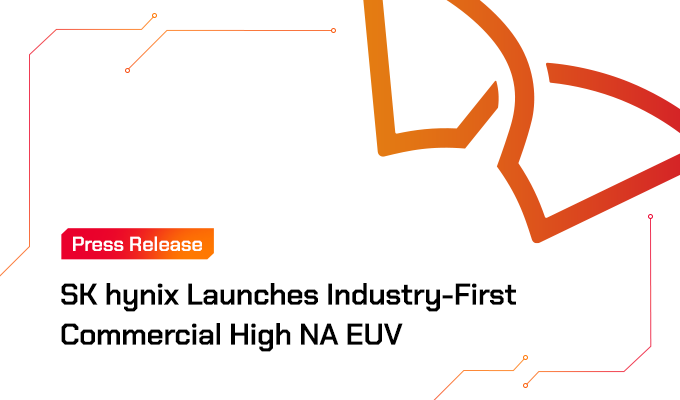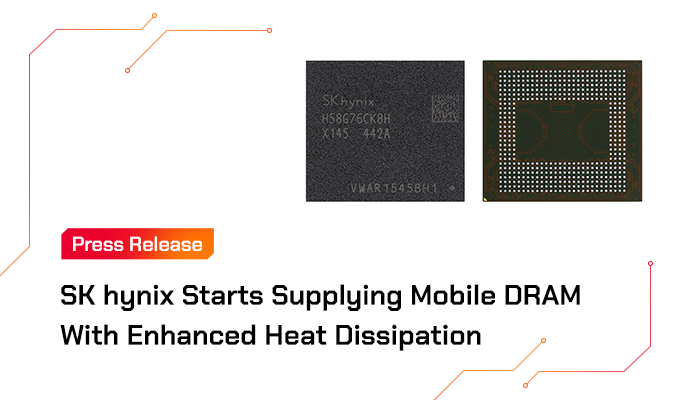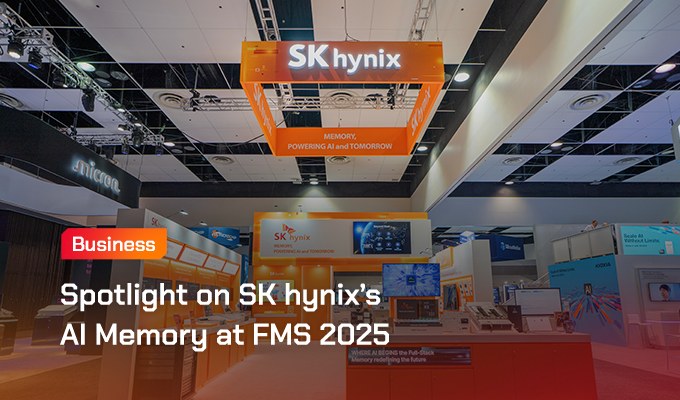Some moments truly test gamers’ patience. The moments when an update notification pops up on screen when you don’t have enough space to install your new game right away, or when you have to wait forever for the game to be installed. If you have had any of these experiences of wasting your time when you wish you could be playing a game, you might have already gone through the limitation of your patience.
But this tedious waiting ends soon. As 5G service begins in earnest and computing technologies keep developing, the popularization of “cloud gaming” is going to be realized soon. Cloud gaming allows users to play games right away with any internet-connected device, without any installation process. It means that gamers’ “Brave New World” is finally opening.
New Gaming Environment Using “Cloud Service”

Cloud gaming is a kind of streaming service1. All a user needs to enjoy the game is an input device and a displaying device to show the gaming screen. Data required for playing the game is stored within the central server, instead of individual devices. Data processing and calculation to execute input orders are also done in the central server, where the data is installed.
There are two general methods of streaming a cloud game. “Video” streaming method transmits the gaming data saved in the server to individual devices via a relay point called “thin client”; the data is also transmitted from individual devices to the server through this when saving as well. As thin clients play only a role of facilitating the data transmission between the server and the user, small memory capacity is enough for them to function. The other method is the “file” streaming method, which first uses the minimum amount of cache to start the game initially, and then downloads the required data as the game proceeds.2
In other words, in a cloud gaming service, transmitting the control value entered by the user with a controller, and displaying the received game execution results on the screen are all that users’ devices do. Cloud gaming is a totally different mechanism compared to the one in previous games where all the tasks were done in users’ devices. It allows users to enjoy high-spec games without a high-end computing system or a large storage capacity to install the data.
One of the other strengths of cloud gaming is that users can enjoy the same gaming content on different devices anytime, anywhere. It is because both the installation and additional updates are all done in servers in real time. For example, users can continue playing the game on their mobile device that was previously played on a PC, by receiving the previous gaming data via servers. Also, with cloud gaming service, video games that were previously available only on consoles can be played on tablet devices as well.
It is expected that the latest online games or virtual reality (VR) games that were previously only available on high-spec PC can be played on a TV or a smartphone, simply by attaching a tiny, network-connected console device.
Gaming Industry’s “Survival Competition” Triggered by Semiconductors, and the Acceleration of Profit Model Changes Led by Cloud Gaming
The gaming industry expects that as cloud gaming provides innovative gaming environments, it will become the next-gen gaming platform. Some even think that cloud gaming is the only way to survive in the fierce competition in the gaming industry, because the game graphics are improving and the volume of data required for a game is getting larger, all of which require more and more hardware specs to run a game.
For the first time in the industry, “Final Fantasy 15” which was released last year required storage capacity exceeding 100GB. Along with that, the latest video game “Call of Duty: Modern Warfare” cannot even run without more than 175GB of storage space (according to the official minimum specification). A game requiring more than 200GB storage space will soon appear in the near future. This means that most storage capacity of a 256GB SSD would be needed to store the data of one single game.
This situation encourages users to purchase a separate storage device or a high-spec PC in order to play certain games, and it’s not favorable for both users and video game companies which want to sell more game packages to a larger number of users.

In particular, the appearance of the new graphic technology called “Ray tracing” is expected to be the crucial turning point. Ray tracing literally tracks back rays to light sources from the viewpoint (“camera”) in order to calculate how rays interfere with objects that the graphic engine aim to visualize. It is the more advanced method of graphics processing because instead of simply visualizing the surface of the objects which our eyes see, the processing unit “simulates” lighting environment surrounding the objects and as a result displays them as they look in the real life.3
In August 2018, NVIDIA unveiled new graphics processing unit (GPU) – GeForce RTX based on Turing architect which supports ray tracing graphics rendering, enhancing the graphics quality in video games to the actual real life level. The problem is that the realization of ray tracing in a gaming console is not that easy, unlike in a PC where Ray Tracing can be realized simply by adopting NVIDIA’s GeForce RTX series graphics card. While the price of a console is around USD 400, the price range of GeForce RTX is approximately from USD 400 to 1,000. Considering the profit structure of the current gaming console industry, it is not easy to equip a ray tracing-capable graphics card on a gaming console.4 This means global video game companies focusing on gaming consoles are now in a situation where they have to seek for a new breakthrough.
The field that is considered as a breakthrough is the cloud gaming service. Through the IR Day 2019 in May, Sony unveiled the next-generation PlayStation (PS), which can realize ray tracing technology, and announced its strategies for cloud gaming in the future. The main point was that it will reinforce PS4’s remote play function, adding a role of a small-sized home data center to the next-gen PS console. There are a number of video games which used to be exclusive on PS consoles, but Sony now plans to allow users to enjoy these video games on different devices, by connecting the PS console with other devices such as PCs and smartphones via network.
Likewise, at the world’s largest video game exhibition “E3 2019” in June, Microsoft also presented its cloud gaming technology called “Project xCloud,” with which users can play high-resolution, high-capacity Xbox games on a smartphone without any download and installation process. As Microsoft has been already operating Azure server in 140 countries and 56 regions, a high level of stability is expected. In South Korea, Microsoft has been providing a test service since October last year, through a partnership with SK Telecom.
Global IT Big Players Join the Battle to Dominate the Growing Cloud Gaming Market
It is expected that this kind of paradigm change would offer a new opportunity to global IT companies which have been providing cloud services for a long time. It is because they can utilize their excellent data server infrastructure with no extra investment, which they have established for the existing business. For example, IT companies with little relation to the gaming industry such as Google and Amazon are taking aggressive actions in the cloud gaming industry.
Google started to provide a cloud gaming platform service based on its web browser (Chrome), called Stadia, from November 19th, in North America and 19 countries in Europe. The biggest strength of Stadia is Google’s IT infrastructure. In the market, it is pointed out that Google has more competitive advantages compared to its competitors in terms of its capability for operating servers, as Google operates diverse services from web search engine, video streaming service (YouTube), to its own cloud service.
Another IT company with high expectations in the cloud gaming industry is Amazon, which provides a live video streaming service called Twitch. Amazon is also one of the global top cloud business operators. In 2017, Amazon took over GameSparks, a cloud gaming service provider in England and Ireland. Early last year, its plan for launching a cloud gaming platform was unveiled through a local media outlet, and the industry also expects that Amazon’s new cloud gaming platform will be launched in 2020.

It is expected that the size of the cloud gaming market will grow very rapidly. According to the report announced in April 2019 by the global market information provider IHS Markit, the size of the cloud gaming market was USD 387 million (KRW 470 billion) in 2018, and that it will reach USD 2.5 billion (KRW 3.04 trillion) in 2023, by over six times.
“5G Network Innovation,” the Key to the Popularization of Cloud Gaming
Since early 2000, the gaming industry has been focusing on the development of cloud gaming service to dominate the market in advance. In terms of technology, the first cloud gaming technology was presented by G-cluster at E3 in 2000. In terms of service, an early-stage cloud gaming service presented by Onlive in 2010 is considered to be the first one.
However, cloud gaming services in the early stage lacked competitiveness to be popularized. The latency occurred in certain internet environment, causing the delayed responses to users’ input. Another problem was the low video resolution during gameplay due to the need for compression of transmitted data.5 Especially, in the case of online games where multiple users access to the same network, network issues were frequent. Expensive service fees were another obstacle for popularization of the early cloud gaming service as well.
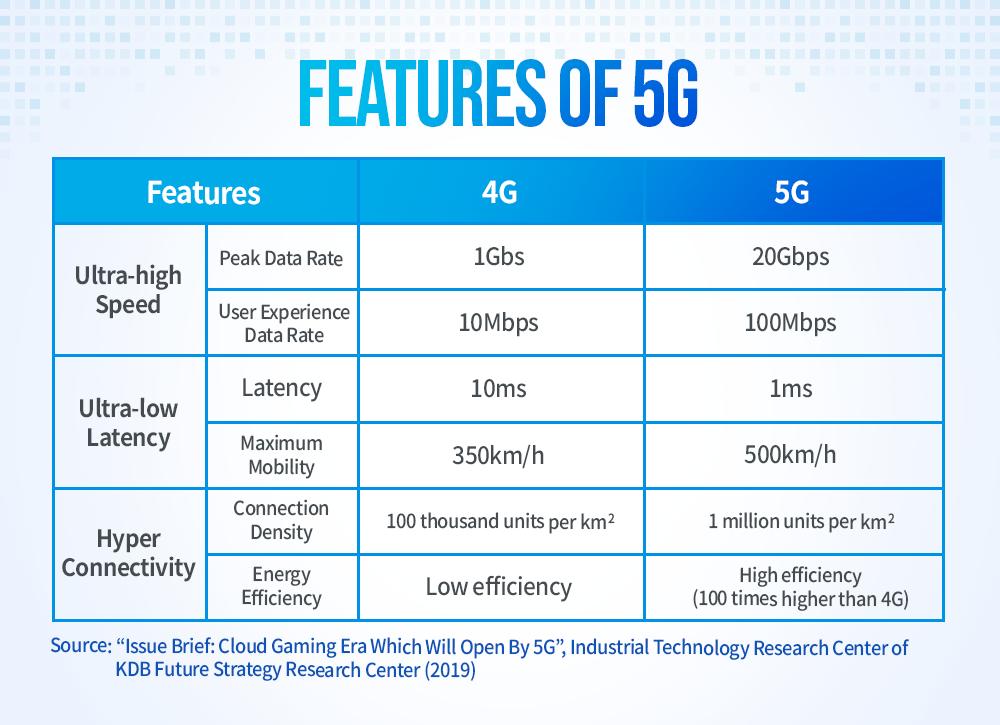
Nonetheless, with the commercialization of 5G technology, a new era for cloud gaming has arrived. The minimum internet data transfer rate required for cloud gaming service is approximately 10Mbps.6) In theory, 4G network environment with peak rate of 1Gbps, latency of 10ms, and user-experience rate of 10Mbps is sufficient for the operation of cloud gaming services. However, when it comes to the user-experience gaming environment, 4G network based cloud gaming is not sufficient compared to the previous gaming mechanism which runs video games utilizing local data installed in the individual device.
On the contrary, 5G network environment supports peak rate of 20Gbps, latency of 1ms, and user-experience rate of 100Mbps, enabling cloud gaming to be operated smoothly. Specifically, 5G supports one-tenth of latency compared to 4G, which is critical in user order input/output delay issues. It is expected that a real-time gaming environment can be established with 5G. Considering the actual gaming environment where multiple users are connected to one single server, this gap is even more significant.
5G and “Memory Semiconductors,” Putting the Finishing Touch to Cloud Gaming
Once the cloud gaming service is commercialized, one single server must be able to process numerous subscribers’ game data at once. While it depends on the number of subscribers, the semiconductor industry is expecting that hundreds of Zeta FLOPS7 of data will be generated in the cloud gaming service a day around 2021 to 2022.
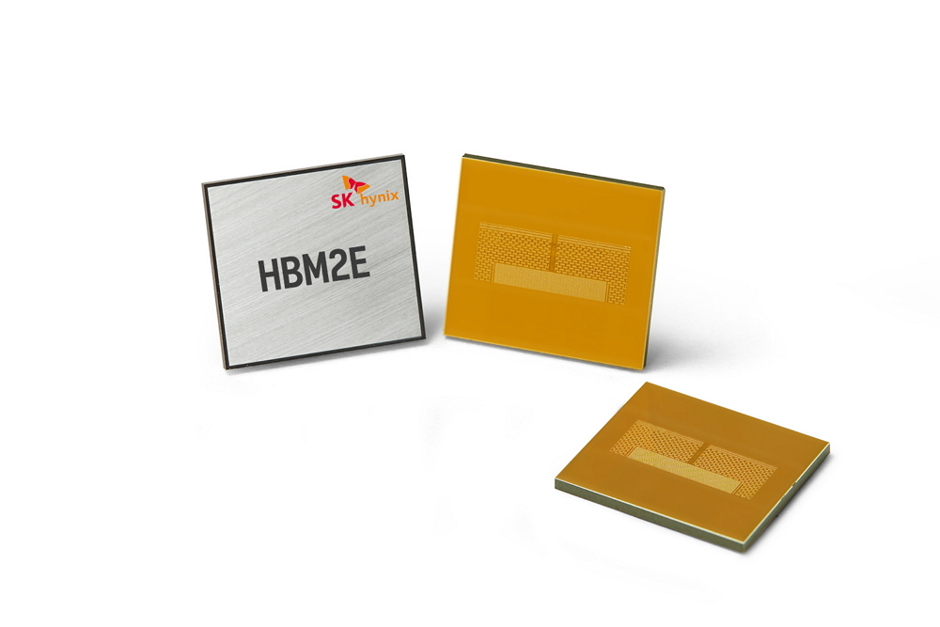
To process the enormous amount of data, data servers usually utilize a High Bandwidth Memory (HBM). While the number of data passages (input/output, IOs) in the current DRAM is 4, 8, or 16 at most, HBM provides 1,024 IOs. This means that HBM can calculate a large volume of data at once, contributing to improving the data processing rate in a server.
Byoungjin Jung, Technical Leader (TL) of PC Client / Embedded at DRAM Product Planning at SK hynix said, “In data centers, adoption of DRAMs over 1,024 IOs such as HBM products will be expanded. While DDR4 will be utilized as main products in general, the shift to DDR5 is expected in a few years.”
In the course of processing game data on a server, the role of graphic DRAMs which help data processing in an accelerator is very important. As a kind of GPU, an accelerator has multiple cores so that it can execute multiple calculations simultaneously, unlike a central processing unit (CPU) where data is processed in high speed with one single core. With this feature, accelerators are mainly used for big data or artificial intelligence (AI) technologies recently. Furthermore, they are playing a key role in processing a large volume of data in cloud servers.
Graphic DRAMs store required data whilst calculations are made in each core within an accelerator, then receive and transfer the calculated data. The performance of existing GDDR6, or even below GDDR6 level is totally enough to process the calculations required for cloud gaming service.
Whan-young Choi, TL of Graphic / Auto at DRAM Product Planning said, “As graphic DRAM’s performance improves, a larger volume of data can be saved at once, and the time required for reading and writing the data can be shortened. The future technological development will be focused on enhancing the processing efficiency within the same amount of physical space.”

Memory semiconductors are also essential for establishing a 5G network environment, which is one of the prerequisites for the cloud gaming service. Network-specified DRAMs are equipped to the individual network device, storing packet data while the device system decides where to transfer certain packet data and which one to process first, and calculates them.
“To rapidly transfer the data calculated within the network system, a DRAM of a relatively high bandwidth is necessary. Also, as the DRAM must function in a wireless environment, efforts to reduce the power consumption should be made as well,” said Byoungjin Jung “Accordingly, it is anticipated that more than 256 IOs for each system will be required, and for this, 4CH products of LPDDR lineup or customized LPDDR products specialized in securing IOs should be crucial.”
1A service which transfers and plays multimedia files such as audio (music) or video files in real time by utilizing networks
2“Content Industry Trend of the U.S.: Current Status and Outlook of the U.S. Cloud Gaming”, Korea Creative Content Agency (2019)
3Yoon-ku Kwon and Hee-seok Jeong, “Korea Investment & Securities Co., Ltd. Global Company Issues Next Big Thing: Cloud Gaming Industry”, Korea Investment & Securities Co., Ltd. (2018)
4Yoon-ku Kwon and Hee-seok Jeong, “Korea Investment & Securities Co., Ltd. Global Company Issues Next Big Thing: Cloud Gaming Industry”, Korea Investment & Securities Co., Ltd. (2018)
5In-ae, Jang, “Global Cloud Gaming Market Trend with the Arrival of 5G Era”, National IT Industry Promotion Agency (2019)
6“Global Gaming Industry Trend: Influence of 5G on Gaming Industry and 5G Policies by Major Countries”, Korea Creative Content Agency (2019)
7Floating-Point Operations per Second (FLOPS) is the number of operations made in floating-point levels in one second. In this context, it is used as a unit representing the volume of data processed. Zeta is a unit representing 1 sextillion (1021).



